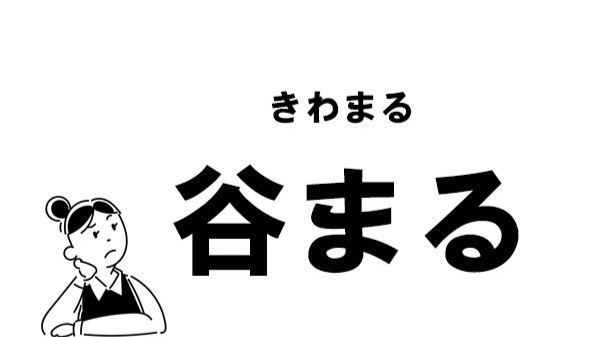進退谷まる "To be stuck with no way out." This is a somewhat well-known expression in Japanese, but its reason for its inclusion in the Kanji Kentei level 1 learning materials is fascinating. The first two characters, shin and tai mean “to move forward” and “retreat,” and kiwamaru (which we normally write as either 極まるor 窮まる) here means something to the effect of “running out,” or “reaching its limit.” In other words, there is no way to move forward or retreat. It’s like the English phrase “to be stuck between a rock and a hard place.” Although modern Japanese speakers seldomly seem to write it this way anymore, the kiwamaru should be written here with the character 谷, which is pronounced tani in the Japanese kunyomi reading, sometimes ya in place names like Shibuya, and koku in its most common Chinese-derived onyomi reading. This is an incredibly uncommon reading for this character, and this is the reason for its inclusion in the test materials. Then how did the word for “valley” come to be used as a verb in this expression?
We have a 3000-year-old Chinese book to blame for this: the Shijing, or Shikyo in its Japanese reading, known as the Classic of Poetry in English. It appears in this song (translation my own):
瞻彼中林、牲牲其鹿。
Look at the forest, where the deer roam together in harmony
朋友已譖、不胥以穀。
My friends are duplicitous, and do not help one another
人亦有言、進退維谷。
As the saying goes, one can neither go forwards, nor backwards
This anonymous song is very likely from the perspective of an aristocrat at the royal court of the Zhou dynasty, lamenting the fact that, although the deer are able to live in harmony, his colleagues are not, and constantly betray one another. It leaves him feeling like there is no way out, which he describes 進退維谷 jintui wei gu, the original Chinese rendition of this saying. Judging from this song, it seems this was already a well-known saying at the time.
Despite the fact that it is most likely around 3000 years old, the song is still mostly readable to most modern Chinese. For contrast, the Japanese language did not even have a writing system until 1500 years ago, when the Chinese writing system was first comprehensively introduced into the archipelago. This saying is also still very well-known among modern speakers of Chinese, but if we were to press most speakers about what the character for “valley” is doing here, many Chinese would be left without a clear explanation. Its meaning of “to run out,” or “reach its limit,” would be incomprehensible to a contemporary Chinese reader otherwise. 3000 years is an incredibly long time for language, and even though the written (crucial here) representation of Chinese gives the language remarkable readability over time, many words and expressions have come and gone in this time span. It makes it all the more impressive that this song survived to us, and that the saying introduced in it is still well-known across East-Asia. Coincidentally, it has also survived into Modern Korean as jin toe yu gok 진퇴유곡, where the “gok” is the Korean reading of 谷.
We have later commentaries to thank for explaining the meaning of this character to us. The Mao Shijing, or Mao Poetry, probably only 2300 years old and the only of the traditional interpretations to survive, simply explains this as gu, qiong ye 谷,窮也, or in other words: gu 谷 is akin to gu 窮. We can imagine that, without this commentary, later readers of Chinese would have simply read it as: “whether to retreat or advance, the only way is through the valley,” which means we would have interpreted it as a simple noun. The Mao Poetry interpretation of 谷 as a verb eventually made it into the Japanese language when it started using the Chinese written language and script. Because the Japanese language was structurally fundamentally different from Chinese, the Japanese eventually devised a method of reading the classical written Chinese language, the lingua franca of East Asia, in a stylized form of Japanese known as kundoku. Since they had to render the character for “valley” 谷 as a verb, they took the Chinese interpretation of “to reach its limit,” and superimposed it onto the native Japanese verb kiwamaru.
In its Japanized form, the saying eventually became a staple in Japanese as well. It was used in the 13th century epic The Tale of Heike, for example. Although the saying is not used very commonly in modern colloquial Japanese anymore, it can still appear in literary or formal contexts. It is incredible for a 3000-year old Chinese saying to survive into modern Japanese, especially this highly unusual of the character for “valley” 谷, although we do have to note it is usually rendered with the more usual 窮, and the usage of 谷 is reserved for true classical prescriptivists. Don’t judge me!




A delightful essay. Thank you.